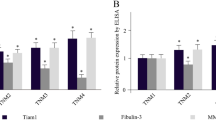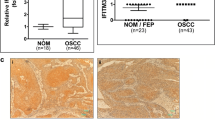Abstract
To discover the effect of tumor necrosis factor-alpha-induced protein 8-like 2 (TIPE2) on the oral tongue squamous cell carcinoma (OTSCC) via affecting FoxP3+ regulatory T (Treg) cells. Immunohistochemistry was conducted to examine TIPE2 and FoxP3 expressions in OTSCC tumor tissues and corresponding oral mucosa. Tca8113 cells were transfected with TIPE2/control lentiviral activation particles followed by the detection with qRT-PCR, Western blotting, MTT assay, Wound healing, Transwell assay and Annexin V-FITC/PI staining. In vivo experiment was carried out on the nude mice xenografts of OTSCC with TIPE2 overexpression to observe the tumor volume and survival, and the CD4+ T cell subgroups were detected by flow cytometry. TIPE2 was lower in the OTSCC tissues than the corresponding oral mucosa, which was correlated with T stage, N stage, TNM stage, and differentiation of patients. Patients with TIPE2-positive expression had worse prognosis and lower expression of FoxP3+ Treg cells than the negative ones. Furthermore, TIPE2 overexpression curbed proliferation, invasion and migration of Tca8113 cells, while cell apoptosis was increased. Besides, TIPE2 suppressed the tumor growth and extended the survival of OTSCC mice, with the decreased proportion of FoxP3+ Treg cells in the spleen and tumor-infiltrated lymphocytes (TILs). The clinical results showed the down-regulation of TIPE2 in OTSCC tissues. Meanwhile TIPE2 overexpression affected OTSCC cells biological behavior in vitro, as well as exhibited strong tumor-growth suppressive effects in vivo, which may be a potential therapeutic target in OTSCC via regulating FoxP3+ Treg cells.





Similar content being viewed by others
References
Bordoloi D, Banik K, Shabnam B, Padmavathi G, Monisha J, Arfuso F, et al. (2018) TIPE Family of Proteins and Its Implications in Different Chronic Diseases. Int J Mole Sci. 19(10)
Bordoloi D, Banik K, Padmavathi G, Vikkurthi R, Harsha C, Roy NK, et al. (2019) TIPE2 Induced the Proliferation, Survival, and Migration of Lung Cancer Cells Through Modulation of Akt/mTOR/NF-kappaB Signaling Cascade. Biomolecules. 9(12)
Borst J, Ahrends T, Babala N, Melief CJM, Kastenmuller W (2018) CD4(+) T cell help in cancer immunology and immunotherapy. Nat Rev Immunol 18(10):635–647
Cao X, Zhang L, Shi Y, Sun Y, Dai S, Guo C, Zhu F, wang Q, Wang J, Wang X, Chen YH, Zhang L (2013) Human tumor necrosis factor (TNF)-alpha-induced protein 8-like 2 suppresses hepatocellular carcinoma metastasis through inhibiting Rac1. Mol Cancer 12(1):149
Deng B, Feng Y, Deng B (2015) TIPE2 mediates the suppressive effects of Shikonin on MMP13 in osteosarcoma cells. Cellular physiology and biochemistry : international journal of experimental cellular physiology, biochemistry, and pharmacology 37(6):2434–2443
Ding J, Su J, Zhang L, Ma J (2015) Crocetin activates Foxp3 through TIPE2 in asthma-associated Treg cells. Cellular Physiol Biochem: Int J Exp Cell Physiol, Biochem, Pharm 37(6):2425–2433
Fan YC, Wang N, Sun YY, Xiao XY, Wang K (2015) TIPE2 mRNA level in PBMCs serves as a novel biomarker for predicting short-term mortality of acute-on-chronic hepatitis B liver failure: a prospective single-center study. Medicine (Baltimore) 94(39):e1638
Fan T, Huang X, Liu C, Liu R, Wang T, Ruan Q (2018) Egress of murine regulatory T cells from the thymus requires TIPE2. Biochem Biophys Res Commun 500(2):376–383
Gonzaga AKG, Santos HBP, Crispim JCO, Souza LB, Palomino GM (2019) Immunohistochemical evaluation of HLA-G and FoxP3+ T regulatory cells in oral cavity and lower lip squamous cell carcinomas. Brazilian oral research 33:e020
Gus-Brautbar Y, Johnson D, Zhang L, Sun H, Wang P, Zhang S, Zhang L, Chen YH (2012) The anti-inflammatory TIPE2 is an inhibitor of the oncogenic Ras. Mol Cell 45(5):610–618
Gu-Trantien C, Loi S, Garaud S, Equeter C, Libin M, de Wind A, Ravoet M, le Buanec H, Sibille C, Manfouo-Foutsop G, Veys I, Haibe-Kains B, Singhal SK, Michiels S, Rothé F, Salgado R, Duvillier H, Ignatiadis M, Desmedt C, Bron D, Larsimont D, Piccart M, Sotiriou C, Willard-Gallo K (2013) CD4(+) follicular helper T cell infiltration predicts breast cancer survival. J Clin Invest 123(7):2873–2892
Hanakawa H, Orita Y, Sato Y, Takeuchi M, Ohno K, Gion Y, Tsukahara K, Tamamura R, Ito T, Nagatsuka H, Nishizaki K, Yoshino T (2014) Regulatory T-cell infiltration in tongue squamous cell carcinoma. Acta Otolaryngol 134(8):859–864
Hao C, Zhang N, Geng M, Ren Q, Li Y, Wang Y, Chen YH, Liu S (2016) Clinical significance of TIPE2 protein Upregulation in non-Hodgkin's lymphoma. J Histochem Cytochem: Off J Histochem Soc 64(9):556–564
Jia L, Gui B, Tian P, Yao G, Fu R, Wang L, Ge H, Ou Y (2013) TIPE2, a novel biomarker for clinical chronic kidney allograft rejection. Artif Organs 37(2):221–225
Jia W, Li Z, Chen J, Sun L, Liu C, Wang S, Chi J, Niu J, Lai H (2018) TIPE2 acts as a biomarker for tumor aggressiveness and suppresses cell invasiveness in papillary thyroid cancer (PTC). Cell & bioscience 8:49
Kheirollahi K Correlation between chronic inflammation and oral squamous cell carcinoma (OSCC). Oral Oncol 50(10):e52
Kosmehl H (2006) Current classification of precursor lesions of oral squamous cell carcinoma principles of the WHO classification 2005. Mund Kiefer Und Gesichtschirurgie 10(2):89–93
Li Y, Li X, Liu G, Sun R, Wang L, Wang J, Wang H (2015) Downregulated TIPE2 is associated with poor prognosis and promotes cell proliferation in non-small cell lung cancer. Biochem Biophys Res Commun 457(1):43–49
Li Z, Guo C, Liu X, Zhou C, Zhu F, Wang X, Wang Q, Shi Y, Wang J, Zhao W, Zhang L (2016) TIPE2 suppresses angiogenesis and non-small cell lung cancer (NSCLC) invasiveness via inhibiting Rac1 activation and VEGF expression. Oncotarget. 7(38):62224–62239
Liu QQ, Zhang FF, Wang F, Qiu JH, Luo CH, Zhu GY, Liu YF (2015) TIPE2 inhibits lung Cancer growth attributing to promotion of apoptosis by regulating some apoptotic molecules expression. PLoS One 10(5):e0126176
Liu W, Fan Y, Shi Y, Lin Z, Huang X, Huang W, Shen D, Qi Z (2018) Knockdown of TIPE2 increases the proliferation in lipopolysaccharide-stimulated gastric cancer cells. BMC Cancer 18(1):857
Luan YY, Yao YM, Zhang L, Dong N, Zhang QH, Yu Y, Sheng ZY (2011) Expression of tumor necrosis factor-alpha induced protein 8 like-2 contributes to the immunosuppressive property of CD4(+)CD25(+) regulatory T cells in mice. Mol Immunol 49(1–2):219–226
Ma Y, Liu X, Wei Z, Wang X, Wang Z, Zhong W, Li Y, Zhu F, Guo C, Zhang L, Wang X (2013) The expression and significance of TIPE2 in peripheral blood mononuclear cells from asthmatic children. Scand J Immunol 78(6):523–528
Mason TJ, Matthews M (2012) Aquatic environment, housing, and management in the eighth edition of the guide for the care and use of laboratory animals: additional considerations and recommendations. J Am Assoc Lab Anim Sci 51(3):329–332
Montes HZ (2010) TNM Classification of Malignant Tumors, 7th edition. Int J Rad Oncol Biol Physics 78(4):1278
Naruse T, Yanamoto S, Yamada SI, Takahashi H, Matsushita Y, Imayama N et al (2015) Immunohistochemical study of vascular endothelial growth factor-C/vascular endothelial growth factor receptor-3 expression in oral tongue squamous cell carcinoma: correlation with the induction of lymphangiogenesis. Oncol Lett 10(4):2027–2034
Nicoletti G, Soutar DS, Jackson MS, Wrench AA, Robertson G (2004) Chewing and swallowing after surgical treatment for oral cancer: functional evaluation in 196 selected cases. Plast Reconstr Surg 114(2):329–338
Oho M, Nakano R, Nakayama R, Sakurai W, Miyamoto A, Masuhiro Y, Hanazawa S (2016) TIPE2 (tumor necrosis factor alpha-induced protein 8-like 2) is a novel negative regulator of TAK1 signal. J Biol Chem 291(43):22650–22660
Padmavathi G, Banik K, Monisha J, Bordoloi D, Shabnam B, Arfuso F, Sethi G, Fan L, Kunnumakkara AB (2018) Novel tumor necrosis factor-alpha induced protein eight (TNFAIP8/TIPE) family: functions and downstream targets involved in cancer progression. Cancer Lett 432:260–271
Rabinovich GA, Gabrilovich D, Sotomayor EM (2007) Immunosuppressive strategies that are mediated by tumor cells. Annu Rev Immunol 25:267–296
Rajendran M, Looney S, Singh N, Elashiry M, Meghil MM, El-Awady AR et al (2019) Systemic antibiotic therapy reduces circulating inflammatory dendritic cells and Treg-Th17 plasticity in periodontitis. J Immunol 202(9):2690–2699
Robbins PF (2017) Tumor-infiltrating lymphocyte therapy and Neoantigens. Cancer J 23(2):138–143
Sadahiro S, Suzuki T, Tanaka A, Okada K, Saito G, Miyakita H et al (2019) Induction of CD3+ and FoxP3+ T cells in left-sided colorectal tumors after UFT/LV chemotherapy. Anticancer Res 39(4):1997–2005
Serpa MS, Mafra RP, Queiroz S, Silva LPD, Souza LB, Pinto LP (2018) Expression of urokinase-type plasminogen activator and its receptor in squamous cell carcinoma of the oral tongue. Brazilian oral research. 32:e93
Tsubaki T, Kadonosono T, Sakurai S, Shiozawa T, Goto T, Sakai S, Kuchimaru T, Sakamoto T, Watanabe H, Kondoh G, Kizaka-Kondoh S (2018) Novel adherent CD11b(+) gr-1(+) tumor-infiltrating cells initiate an immunosuppressive tumor microenvironment. Oncotarget. 9(13):11209–11226
Wang Y, Jiang Y, Zhou J, Song W, Li J, Wang M, Chen J, Xu R, Zhang J, Ma F, Chen YH, Ma Y (2016) Hepatitis C virus promotes hepatocellular carcinogenesis by targeting TIPE2, a new regulator of DNA damage response. Tumour biology : the journal of the International Society for Oncodevelopmental Biology and Medicine 37(11):15265–15274
Wang K, Ren Y, Liu Y, Zhang J, He JJ (2017) Tumor necrosis factor (TNF)-alpha-induced protein 8-like-2 (TIPE2) inhibits proliferation and tumorigenesis in breast Cancer cells. Oncol Res 25(1):55–63
Wei T, Zhang J, Qin Y, Wu Y, Zhu L, Lu L, Tang G, Shen Q (2015) Increased expression of immunosuppressive molecules on intratumoral and circulating regulatory T cells in non-small-cell lung cancer patients. Am J Cancer Res 5(7):2190–2201
Wu T, Zhang L, Xu K, Sun C, Lei T, Peng J, Liu G, Wang R, Zhao Y (2012) Immunosuppressive drugs on inducing Ag-specific CD4(+)CD25(+)Foxp3(+) Treg cells during immune response in vivo. Transpl Immunol 27(1):30–38
Wu DD, Liu SY, Gao YR, Lu D, Hong Y, Chen YG, Dong PZ, Wang DY, Li T, Li HM, Ren ZG, Guo JC, He F, Ren XQ, Sun SY, Duan SF, Ji XY (2019) Tumour necrosis factor-alpha-induced protein 8-like 2 is a novel regulator of proliferation, migration, and invasion in human rectal adenocarcinoma cells. J Cell Mol Med 23(3):1698–1713
Yu T, Wu Y, Huang Y, Yan C, Liu Y, Wang Z, Wang X, Wen Y, Wang C, Li L (2012) RNAi targeting CXCR4 inhibits tumor growth through inducing cell cycle arrest and apoptosis. Molecular therapy : the journal of the American Society of Gene Therapy 20(2):398–407
Zhang Z, Liu L, Liu C, Cao S, Zhu Y, Mei Q (2016) TIPE2 suppresses the tumorigenesis, growth and metastasis of breast cancer via inhibition of the AKT and p38 signaling pathways. Oncol Rep 36(6):3311–3316
Zhang Q, Huang D, Zhang Z, Feng Y, Fu M, Wei M et al (2019) High expression of TMEM40 contributes to progressive features of tongue squamous cell carcinoma. Oncol Rep 41(1):154–164
Zhao Q, Zhao M, Dong T, Zhou C, Peng Y, Zhou X, Fan B, Ma W, Han M, Liu S (2015) Tumor necrosis factor-alpha-induced protein-8 like-2 (TIPE2) upregulates p27 to decrease gastic cancer cell proliferation. J Cell Biochem 116(6):1121–1129
Zhou WN, Du YF, Zheng Y, Zhang W, Wu YN, Song XM et al (2019) Inactivation of RUNX3 protein expression in tongue squamous cell carcinoma and its association with clinicopathological characteristics. Mol Med Rep 19(2):885–894
Zhu L, Zhang X, Fu X, Li Z, Sun Z, Wu J, Wang X, Wang F, Li X, Niu S, Ding M, Yang Z, Yang W, Yin M, Zhang L, Zhang M (2018) TIPE2 suppresses progression and tumorigenesis of esophageal carcinoma via inhibition of the Wnt/beta-catenin pathway. J Transl Med 16(1):7
Author information
Authors and Affiliations
Corresponding author
Ethics declarations
Conflict of interest
The authors declare that they have no competing interest.
Additional information
Publisher’s note
Springer Nature remains neutral with regard to jurisdictional claims in published maps and institutional affiliations.
Rights and permissions
About this article
Cite this article
Zhao, LL. TIPE2 suppresses progression and tumorigenesis of the oral tongue squamous cell carcinoma by regulating FoxP3+ regulatory T cells. J Bioenerg Biomembr 52, 279–289 (2020). https://doi.org/10.1007/s10863-020-09840-w
Received:
Accepted:
Published:
Issue Date:
DOI: https://doi.org/10.1007/s10863-020-09840-w




